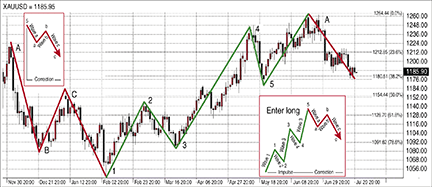CHARTING
Technical Triad 2
Gold And The Corrective Phase
Part 1 of this series discussed using Elliott wave, Fibonacci retracement, and candlestick patterns for analyzing the gold market. Part 2 examines the corrective phase that gold has now entered in this bullish gold run.
Trading the gold market might look easy when you consider that it has gone up $242 in one year. One year! However, anyone involved in gold trading, whether it is through Comex, forex, or exchange traded funds (Etfs), will tell you differently. Follow me as I track the final impulse wave into the current (as of July 21, 2010) corrective phase. Gold was nearing the top of wave 3 about mid-May 2010. Since then, we have completed that wave, ending with a new high of $1,248, only to end up as a footnote as a new all-time high of $1,265 ended wave 5.
Elliott waves
Fundamentally bullish on gold, I think that gold by the first or second quarter of 2011 will take out the new historical high of $1,265 and possibly test $1,300. But before we get there, the yellow metal will need to go through a corrective phase.
As outlined in Elliott wave theory, this correction would consist of three waves — A, B, and C: waves A and C the corrective (bearish) waves and the B wave a predominantly bullish wave.
Figure 1 is a daily chart of forex gold. Starting on the far left, you can see the first correction after gold hit a historical high of $1,221 in December 2009. According to Elliott wave theory, a market trend follows a cycle. That cycle is made up of eight waves. This eight-wave sequence will repeat until the trend is exhausted. This trend structure is composed of eight waves, divided into two phases: the impulse (motive) phase and the corrective phase. The corrective phase is composed of A, B, and C waves. They will move opposite to the primary trend. Waves A and C will be corrective waves, while the B wave will move in the direction of the primary trend. Here we see the corrective phase, wave C, which took gold to a low of $1,045 in February 2010.

Figure 1: daily chart of forex gold. From February 2010 until the end of June 2010, we witnessed an extraordinary bull move in gold, taking it to a new historical high of $1,265. This high would prove to be the top in gold as from there it traded lower, falling under $1,200. This began a corrective phase and the start of corrective wave A.